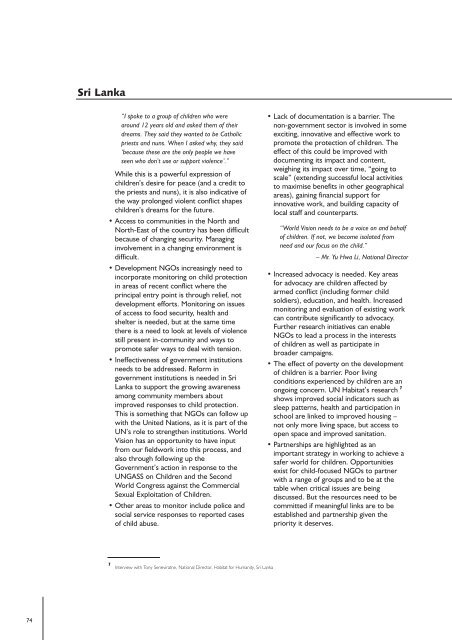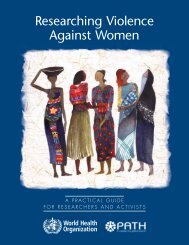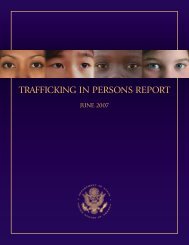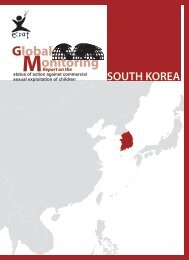Download PDF - Violence Against Children - East Asia and the ...
Download PDF - Violence Against Children - East Asia and the ...
Download PDF - Violence Against Children - East Asia and the ...
You also want an ePaper? Increase the reach of your titles
YUMPU automatically turns print PDFs into web optimized ePapers that Google loves.
Sri Lanka<br />
“I spoke to a group of children who were<br />
around 12 years old <strong>and</strong> asked <strong>the</strong>m of <strong>the</strong>ir<br />
dreams. They said <strong>the</strong>y wanted to be Catholic<br />
priests <strong>and</strong> nuns. When I asked why, <strong>the</strong>y said<br />
‘because <strong>the</strong>se are <strong>the</strong> only people we have<br />
seen who don’t use or support violence’.”<br />
While this is a powerful expression of<br />
children’s desire for peace (<strong>and</strong> a credit to<br />
<strong>the</strong> priests <strong>and</strong> nuns), it is also indicative of<br />
<strong>the</strong> way prolonged violent conflict shapes<br />
children’s dreams for <strong>the</strong> future.<br />
• Access to communities in <strong>the</strong> North <strong>and</strong><br />
North-<strong>East</strong> of <strong>the</strong> country has been difficult<br />
because of changing security. Managing<br />
involvement in a changing environment is<br />
difficult.<br />
• Development NGOs increasingly need to<br />
incorporate monitoring on child protection<br />
in areas of recent conflict where <strong>the</strong><br />
principal entry point is through relief, not<br />
development efforts. Monitoring on issues<br />
of access to food security, health <strong>and</strong><br />
shelter is needed, but at <strong>the</strong> same time<br />
<strong>the</strong>re is a need to look at levels of violence<br />
still present in-community <strong>and</strong> ways to<br />
promote safer ways to deal with tension.<br />
• Ineffectiveness of government institutions<br />
needs to be addressed. Reform in<br />
government institutions is needed in Sri<br />
Lanka to support <strong>the</strong> growing awareness<br />
among community members about<br />
improved responses to child protection.<br />
This is something that NGOs can follow up<br />
with <strong>the</strong> United Nations, as it is part of <strong>the</strong><br />
UN’s role to streng<strong>the</strong>n institutions. World<br />
Vision has an opportunity to have input<br />
from our fieldwork into this process, <strong>and</strong><br />
also through following up <strong>the</strong><br />
Government’s action in response to <strong>the</strong><br />
UNGASS on <strong>Children</strong> <strong>and</strong> <strong>the</strong> Second<br />
World Congress against <strong>the</strong> Commercial<br />
Sexual Exploitation of <strong>Children</strong>.<br />
• O<strong>the</strong>r areas to monitor include police <strong>and</strong><br />
social service responses to reported cases<br />
of child abuse.<br />
• Lack of documentation is a barrier. The<br />
non-government sector is involved in some<br />
exciting, innovative <strong>and</strong> effective work to<br />
promote <strong>the</strong> protection of children. The<br />
effect of this could be improved with<br />
documenting its impact <strong>and</strong> content,<br />
weighing its impact over time, “going to<br />
scale” (extending successful local activities<br />
to maximise benefits in o<strong>the</strong>r geographical<br />
areas), gaining financial support for<br />
innovative work, <strong>and</strong> building capacity of<br />
local staff <strong>and</strong> counterparts.<br />
“World Vision needs to be a voice on <strong>and</strong> behalf<br />
of children. If not, we become isolated from<br />
need <strong>and</strong> our focus on <strong>the</strong> child.”<br />
– Mr. Yu Hwa Li, National Director<br />
• Increased advocacy is needed. Key areas<br />
for advocacy are children affected by<br />
armed conflict (including former child<br />
soldiers), education, <strong>and</strong> health. Increased<br />
monitoring <strong>and</strong> evaluation of existing work<br />
can contribute significantly to advocacy.<br />
Fur<strong>the</strong>r research initiatives can enable<br />
NGOs to lead a process in <strong>the</strong> interests<br />
of children as well as participate in<br />
broader campaigns.<br />
• The effect of poverty on <strong>the</strong> development<br />
of children is a barrier. Poor living<br />
conditions experienced by children are an<br />
ongoing concern. UN Habitat’s research 7<br />
shows improved social indicators such as<br />
sleep patterns, health <strong>and</strong> participation in<br />
school are linked to improved housing –<br />
not only more living space, but access to<br />
open space <strong>and</strong> improved sanitation.<br />
• Partnerships are highlighted as an<br />
important strategy in working to achieve a<br />
safer world for children. Opportunities<br />
exist for child-focused NGOs to partner<br />
with a range of groups <strong>and</strong> to be at <strong>the</strong><br />
table when critical issues are being<br />
discussed. But <strong>the</strong> resources need to be<br />
committed if meaningful links are to be<br />
established <strong>and</strong> partnership given <strong>the</strong><br />
priority it deserves.<br />
7<br />
Interview with Tony Seneviratne, National Director, Habitat for Humanity, Sri Lanka<br />
74

















